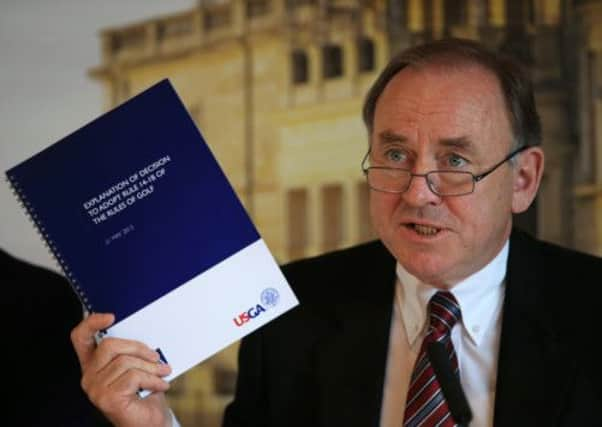Anchored putting: Peter Dawson urges acceptance


And, having addressed every issue thrown at them in the face of a proposal raised towards the end of last year and then mulled over during a 90-day comment period, both the R&A and USGA appear comfortable with their stance.
As from 1 January 2016, anchored putting strokes in golf will be outlawed, the methods used by Keegan Bradley, Webb Simpson, Ernie Els and, most recently, Adam Scott to claim major titles disappearing from the Royal & Ancient game forever after the sport’s two ruling bodies decided it was better late than never to take action they believe is “right for golf”.
Advertisement
Hide AdAdvertisement
Hide AdThey considered arguments that claimed such a move would have a detrimental effect on participation levels and that it was, indeed, too late to take action given that anchoring, in one form or another, has been around in the game for around 30 years yet has only really started to be questioned after players using belly or long putters started to land top titles.
In the end, the R&A and USGA stuck to their guns and, though there is a distinct possibility that at least one player will challenge the decision in court, both organisations believe the decision is in the best interests of the game in the long term.
“We understand the concerns expressed by those who feel disadvantaged by this decision,” states the conclusion in that meaty explanation. “We know that not everyone will agree with our decision. But we hope that the care and love for the game that all have expressed through their participation process will facilitate acceptance of Rule 14-1b when it takes effect.
“Golf is a single worldwide game of fun, skill, challenge, honour and integrity, which is best served by the adherence to a single set of worldwide Rules.”
Hosting the R&A’s annoucement at Wentworth – the USGA was holding a simultaneous press conference at its headquarters at Far Hills in New Jersey – chief exceutive Peter Dawson admitted the matter had been “the most controversial for a long time” and put that down to the fact it involved “high-profile players”.
However, with David Rickman, the R&A’s executive director of rules and equipment, sitting at his side in the Ryder Cup Room at the plush Surrey club as it prepares to host this week’s BMW PGA Championship, the pair presented a strong case as to why the St Andrews-based organisation believes the ban should come into force.
“We received a broad range of feedback during the comment period [the R&A receiving approximately 450 comments and the USGA 2,200 comments] and I think the process has served as very strong reminder about how passionate golfers are about the game no matter their position on this specific issue,” said Dawson.
“Since the end of the consultation period, both organisations have been closely evaluating that input and we are announcing today that the adoption of Rule 14-1b will take effect as part of The Rules of Golf on 1 January 2016. The text of the Rule is the same as that previously proposed.”
Advertisement
Hide AdAdvertisement
Hide AdWith the PGA Tour, with all its might, having voiced its opposition of the proposed ban during the consultation period and Bradley threatening at one point to take court action against it before back-tracking, Dawson was asked if he now feared the matter becoming the focal point of a legal dispute.
“I very much hope not,” he added. “The best interests of the game would be served by this not being divisive, by people getting behind the decision that the governing bodies have made and helping each other get to 2016, where those who have made that adjustment to their game have done so successfully.
“I have a great deal of faith in the essential goodwill of golfers everywhere and their willingness to get behind what the governing bodies have decided. So I’m very hopeful that it won’t come to anything like that.
“I think it’s best for the game that we put this behind us and move forward. I think the governing bodies have always had the right, by consent more than anything else, to make Rule changes down the years and I think people coming into the game know that’s a possibility. Personally, I don’t think lawsuits will be on a particularly strong ground, but I certainly hope we don’t have any.”
Highlighting some of the main points in the “comprehensive report” prepared jointly by the two bodies, Rickman stressed the main reason the ban on anchoring being implemented was due to the fact it didn’t constitute “free-swinging of the entire club” and also “created an unacceptable risk of changing and reducing the challenge of making a stroke”.
He also said changes to the Rules of Golf, updated every four years, are “often made long after a controversy arises” and used other sports such as cricket, rugby and swimming to illustrate that golf wasn’t alone in requiring participants to “abandon or modify” techniques they had developed to their perceived advantage.